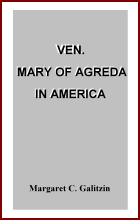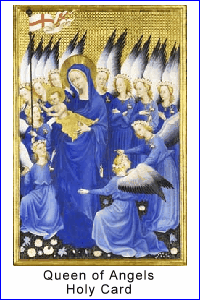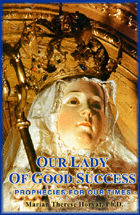Faith under Attack
 |
 |
 |
 |
 |
 |
 |
To Read or Not to Read
The Mystical City of God?
TIA received from a reader the following question, which gives me the opportunity to address an important topic:
Dear TIA,
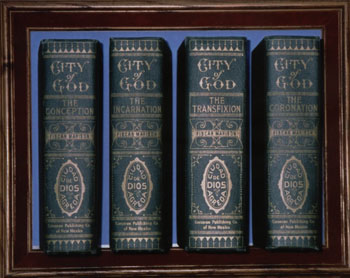 I see that you have recommended the four-volume set titled The Mystical City Of God (here and
here) by Ven. Maria of Agreda. I have always wanted to read this set and so recently purchased it when I found them on sale at a used books store.
I see that you have recommended the four-volume set titled The Mystical City Of God (here and
here) by Ven. Maria of Agreda. I have always wanted to read this set and so recently purchased it when I found them on sale at a used books store.
When I mentioned this to my priest however – a traditionalist priest who says the Latin Mass – he told me that it should not be read because this set was on the List of Forbidden Books (the Index) and so that should be warning for traditional Catholics to beware, since the Index was shut down after Vatican II.
Now I'm confused. This priest is very well read and I trust him very much. But I know many persons who read these books and like them very much. Could you explain why you recommend a book that was on the Index?
Cordially,
In the Immaculate Heart of Mary,
M.T.
Dr. Horvat responds:
Dear M.T.,
TIA highly recommend The Mystical City of God, private revelations given by Our Lord and Our Lady to the Conceptionist nun, Ven. Mary of Agreda. Doing so, we find ourselves in the company of many renowned Popes – including Popes St. Pius X and Pius IX – as well as many other Saints. It would be difficult to find books so closely scrutinized by Church authorities, both religious and civil, and afterwards so signally approved as The City of God.
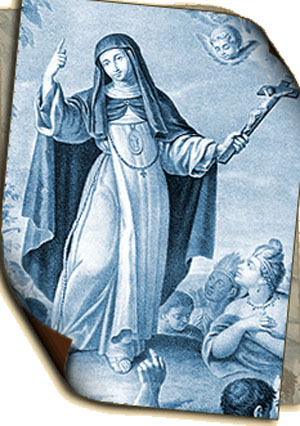 Despite protests and doubts voiced by the incredulous, these approbations were given for centuries, until the post-Conciliar days when seemingly "anonymous orders" came from the Vatican to set it aside for placing too much emphasis on Our Lady. "Not favorable to ecumenism" is the lame excuse to put them under lock and key.
Despite protests and doubts voiced by the incredulous, these approbations were given for centuries, until the post-Conciliar days when seemingly "anonymous orders" came from the Vatican to set it aside for placing too much emphasis on Our Lady. "Not favorable to ecumenism" is the lame excuse to put them under lock and key.
Yes, at times every lock and key. I have a friend who was in the novitiate in a Dominican Convent in the 1980s, and while she was looking for something else she found these books by Mary of Agreda locked away in a chest. When she asked to read them, the Novice Mistress told her they were "dangerous" and forbidden to circulate anymore. Later, after she left the convent, she read them and they were, she told me, the single greatest help to giving her peace and leading her to a true devotion to Our Lady.
It is surprising, then, to find a traditionalist priest who criticizes the work by Ven Mary of Agreda (1602-1665), well known for her 500 bilocations from her convent in Spain to instruct in the Catholic Faith the Jumano Indians in Texas, Arizona and New Mexico and prepare them for Baptism.
Her fame of holiness was so great that less than 10 years after her death, she was declared Venerable by Pope Clement X in honor of her heroic life of virtue. When her casket was opened in 1909, her body was found completely incorrupt and can be seen today in the convent she helped to found in her family home in Agreda.
The priest is not wrong when he says that the book was placed on the Index, but what he forgot to tell you is that such a condemnation was considered unjust and null and that, almost immediately afterwards, its was annulled by Blessed Pope Innocent XI. Let me address the topic.
What is The Mystical City of God?
It was Our Lord himself Who ordered Mother Mary of Agreda to write the volumes to make His Blessed Mother better known in the tumultuous centuries to come. Our Lord told her: "Many mysteries pertaining to my Mother and the Saints have been made manifest in the Church Militant, but many are still hidden, especially the interior secrets of their lives, and these I wish now to make known, and I desire thee to put them down in writing as they are directed by Most Pure Mary."
Our Lady and the Angels revealed the mysteries of the life of Mother of God in relation to her Divine Son, and Mother Mary of Agreda faithfully recorded them at the command of her confessor from 1637 to 1645. Later, obedient to a new confessor, she burned all those writings.
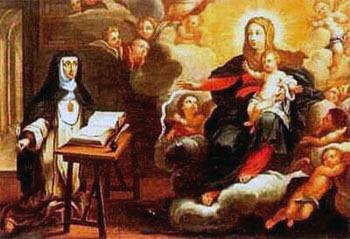 But Our Lady commanded her to rewrite the work, and, at the order of her next confessor, she wrote those books again from 1655 to 1660. In 1670, five years before her death, they were printed for the first time under the title The Mystical City of God: Life of the Virgin Mother of God, after consulting the most prominent theologians at several Universities and Tribunals, all of whom found the work to be immune from any dogmatic error. The work quickly spread throughout Spain and was extolled and welcomed by both clergy and the people.
But Our Lady commanded her to rewrite the work, and, at the order of her next confessor, she wrote those books again from 1655 to 1660. In 1670, five years before her death, they were printed for the first time under the title The Mystical City of God: Life of the Virgin Mother of God, after consulting the most prominent theologians at several Universities and Tribunals, all of whom found the work to be immune from any dogmatic error. The work quickly spread throughout Spain and was extolled and welcomed by both clergy and the people.
The controversy over The City of God
Let me return now to the question of the condemnation which came, I could say, from a petty fight between Friars rather than a question of doctrinal errors. The debate that rose derived essentially from a fierce fight over the Immaculate Conception that the Franciscans of Spain and Dominicans of France were engaged in.
The center of the anti-Immaculate Conception teaching was the Sorbonne University in Paris, which was at this time strongly infected with Jansenism as well as influenced by Gallicanism, which made their partisans antagonistic toward Catholic Spain. The Spanish Franciscans, relying on works by Duns Scotus, strongly defended the teaching of the Immaculate Conception.
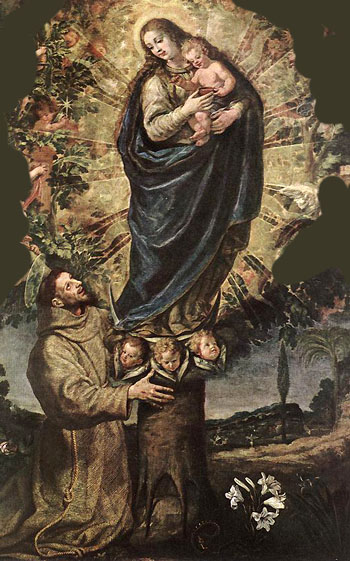 Now then, The Mystical City of God clearly describes the Immaculate Conception, as well as the Assumption of Our Lady; Ven. Mary of Agreda’s position also defends the Mother of God as the Mediatrix of all Graces. When this new publication began to spread outside Spain, it entered the heated terrain of the Franciscan-Dominican controversy.
Now then, The Mystical City of God clearly describes the Immaculate Conception, as well as the Assumption of Our Lady; Ven. Mary of Agreda’s position also defends the Mother of God as the Mediatrix of all Graces. When this new publication began to spread outside Spain, it entered the heated terrain of the Franciscan-Dominican controversy.
Based on a faulty and hastily translated French text of The Mystical City, a majority of the doctors of the Sorbonne condemned The Mystical City of God. The Prohibitive Decree of the University Inquisition was signed on August 4, 1681.
The Sorbonne doctors condemned it for "exaggerated" devotion to the Mother God because of its "Scotist doctrines." Shortly afterward the Roman Tribunal placed it on the Index of Forbidden Books, without either having made a thorough study of the original text or giving the defense a hearing.
The Prohibitive Decree of 1681 immediately raised a thick storm cloud of protests. Even the Spanish royalty – King Charles II, Queen Mary and Queen Louise – appealed to Pope Innocent XI to review the case. He immediately ordered a careful study of the work, and on November 9, 1681, he issued a Brief that removed the Prohibitive Decree and, in opposition to that decree, the Pope decreed that The Mystical City of God was to be freely spread among the clergy and laity. That is to say, The Mystical City of God was on the Index for only three months and five days. (The Age of Mary, Austin: The Dolph Briscoe Center for American History, 2016, Jan-Feb. 1958 issue, p. 52)
The strongest factor for the condemnation was not based on any serious study, but rather was a superficial reaction to favor the party of the Dominicans against the party of the Franciscans.
In an article in L'Universe, Paris, 1859, Dom Prosper Guéranger bitterly protested the irregularities of the proceedings of the Sorbonne condemnation: "Its opponents called Mary of Agreda a Lutheran! The rules of the Faculty were disregarded!"
He went on to cite professors of the Sorbonne who backed him in protesting the decision and who had openly declared that the proceedings had been scandalous and brutal, violating essential formalities. He concluded his examination by declaring their condemnation "entirely unjust, entirely null." (Ibid., p. 47)
Scrutinized & approved
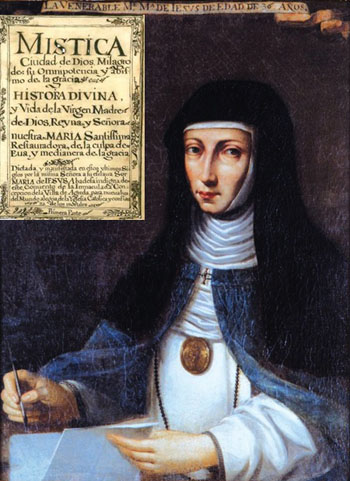 In a certain way, that Prohibitive Decree was useful, because it served to vindicate the orthodoxy of The Mystical City of God. The echo of the Sorbonne condemnation lingered for some time in the Gallican and Jansenist ambience of France and other countries, influenced by Protestantism, which became suspicious of Marian devotions. For that reason, the work was scrutinized and re-scrutinized, studied and restudied. Repeatedly it was subject to the closest scrutiny, and, every time came the same verdict: The Mystical City of God is free from error, authentic and worthy of devout reading.
In a certain way, that Prohibitive Decree was useful, because it served to vindicate the orthodoxy of The Mystical City of God. The echo of the Sorbonne condemnation lingered for some time in the Gallican and Jansenist ambience of France and other countries, influenced by Protestantism, which became suspicious of Marian devotions. For that reason, the work was scrutinized and re-scrutinized, studied and restudied. Repeatedly it was subject to the closest scrutiny, and, every time came the same verdict: The Mystical City of God is free from error, authentic and worthy of devout reading.
After the Prohibitive Decree was removed, the Inquisition examined it exhaustively over a period of 14 years and gave its full approval. Seven of the greatest universities of Spain and 17 other European colleges who established study commissions hailed it enthusiastically.
One after another of learned men of the 17th century praised the work by Ven. Mary of Agreda. For example, Dominican Cardinal Joseph d'Aguirre, requested by the King of France to give his opinion on it, replied as follows: "What I have learned in 50 years is almost nothing compared to the profound teachings that I have found in this book, teachings which agree completely with Holy Scripture, the Fathers and the Councils.
“Since we cannot doubt that even the most learned human being could have given to this Venerable Mother such high teachings and lofty communications in a natural way, we ought to accept and believe with moral certainty that this great servant of God wrote under the inspiration of the Holy Ghost." (Ibid., pp. 54-55)
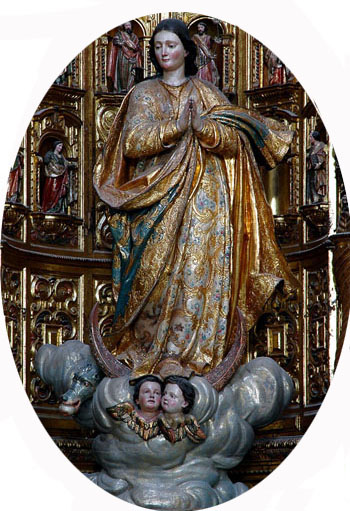 Innocent XI's successor, Pope Alexander VIII, declared: "These books may be read by everyone with impunity." (Ibid., p. 90) Since the time of Clement XIV (1769-1774), almost every occupant of the Chair of St. Peter has approved the work. In more recent times renewed approbations were given by Popes Pius IX, Leo XIII, St. Pius X and Pius XI.
Innocent XI's successor, Pope Alexander VIII, declared: "These books may be read by everyone with impunity." (Ibid., p. 90) Since the time of Clement XIV (1769-1774), almost every occupant of the Chair of St. Peter has approved the work. In more recent times renewed approbations were given by Popes Pius IX, Leo XIII, St. Pius X and Pius XI.
In fact, in a private audience with the American publisher of The Mystical City of God in 1929, Pope Pius XI thanked and praised him for doing this "great work in honor of the Mother of God" and granted the Apostolic Blessing to all readers and promoters of The Mystical City of God. It is affirmed that no book, other than the Bible itself, has received so many imprimaturs as has The Mystical City of God. (Ibid., pp 122-123)
It is a mystery how people – especially priests – can still question this work by Ven. Mary of Agreda and treat it as though there were something dangerous or contrary to the Faith in it.
This work in four marvelous volumes is, I believe, written in particular for the faithless and revolutionary world of the last centuries to help to kindle devotion to the Holy Virgin. This devotion is the antidote for the heresies of our times. It is the perfect remedy to bring souls being led astray by Modernism and Progressivism back to the path of truth.
Cordially,
Marian Horvat, Ph.D.
Dear TIA,

The Mystical City of God presented in a 4-volume set: The Conception, The Incarnation, The Transfixion, The Coronation
When I mentioned this to my priest however – a traditionalist priest who says the Latin Mass – he told me that it should not be read because this set was on the List of Forbidden Books (the Index) and so that should be warning for traditional Catholics to beware, since the Index was shut down after Vatican II.
Now I'm confused. This priest is very well read and I trust him very much. But I know many persons who read these books and like them very much. Could you explain why you recommend a book that was on the Index?
Cordially,
In the Immaculate Heart of Mary,
M.T.
Dr. Horvat responds:
Dear M.T.,
TIA highly recommend The Mystical City of God, private revelations given by Our Lord and Our Lady to the Conceptionist nun, Ven. Mary of Agreda. Doing so, we find ourselves in the company of many renowned Popes – including Popes St. Pius X and Pius IX – as well as many other Saints. It would be difficult to find books so closely scrutinized by Church authorities, both religious and civil, and afterwards so signally approved as The City of God.

Ven. Mary of Agreda teaching the Indians in America in bilocations
Yes, at times every lock and key. I have a friend who was in the novitiate in a Dominican Convent in the 1980s, and while she was looking for something else she found these books by Mary of Agreda locked away in a chest. When she asked to read them, the Novice Mistress told her they were "dangerous" and forbidden to circulate anymore. Later, after she left the convent, she read them and they were, she told me, the single greatest help to giving her peace and leading her to a true devotion to Our Lady.
It is surprising, then, to find a traditionalist priest who criticizes the work by Ven Mary of Agreda (1602-1665), well known for her 500 bilocations from her convent in Spain to instruct in the Catholic Faith the Jumano Indians in Texas, Arizona and New Mexico and prepare them for Baptism.
Her fame of holiness was so great that less than 10 years after her death, she was declared Venerable by Pope Clement X in honor of her heroic life of virtue. When her casket was opened in 1909, her body was found completely incorrupt and can be seen today in the convent she helped to found in her family home in Agreda.
The priest is not wrong when he says that the book was placed on the Index, but what he forgot to tell you is that such a condemnation was considered unjust and null and that, almost immediately afterwards, its was annulled by Blessed Pope Innocent XI. Let me address the topic.
What is The Mystical City of God?
It was Our Lord himself Who ordered Mother Mary of Agreda to write the volumes to make His Blessed Mother better known in the tumultuous centuries to come. Our Lord told her: "Many mysteries pertaining to my Mother and the Saints have been made manifest in the Church Militant, but many are still hidden, especially the interior secrets of their lives, and these I wish now to make known, and I desire thee to put them down in writing as they are directed by Most Pure Mary."
Our Lady and the Angels revealed the mysteries of the life of Mother of God in relation to her Divine Son, and Mother Mary of Agreda faithfully recorded them at the command of her confessor from 1637 to 1645. Later, obedient to a new confessor, she burned all those writings.

Our Lady & Our Lord dictated the work
to Mother Mary of Agreda
The controversy over The City of God
Let me return now to the question of the condemnation which came, I could say, from a petty fight between Friars rather than a question of doctrinal errors. The debate that rose derived essentially from a fierce fight over the Immaculate Conception that the Franciscans of Spain and Dominicans of France were engaged in.
The center of the anti-Immaculate Conception teaching was the Sorbonne University in Paris, which was at this time strongly infected with Jansenism as well as influenced by Gallicanism, which made their partisans antagonistic toward Catholic Spain. The Spanish Franciscans, relying on works by Duns Scotus, strongly defended the teaching of the Immaculate Conception.

Duns Scotus (1265-1308) defended the Immaculate Conception of Our Lady
Based on a faulty and hastily translated French text of The Mystical City, a majority of the doctors of the Sorbonne condemned The Mystical City of God. The Prohibitive Decree of the University Inquisition was signed on August 4, 1681.
The Sorbonne doctors condemned it for "exaggerated" devotion to the Mother God because of its "Scotist doctrines." Shortly afterward the Roman Tribunal placed it on the Index of Forbidden Books, without either having made a thorough study of the original text or giving the defense a hearing.
The Prohibitive Decree of 1681 immediately raised a thick storm cloud of protests. Even the Spanish royalty – King Charles II, Queen Mary and Queen Louise – appealed to Pope Innocent XI to review the case. He immediately ordered a careful study of the work, and on November 9, 1681, he issued a Brief that removed the Prohibitive Decree and, in opposition to that decree, the Pope decreed that The Mystical City of God was to be freely spread among the clergy and laity. That is to say, The Mystical City of God was on the Index for only three months and five days. (The Age of Mary, Austin: The Dolph Briscoe Center for American History, 2016, Jan-Feb. 1958 issue, p. 52)
The strongest factor for the condemnation was not based on any serious study, but rather was a superficial reaction to favor the party of the Dominicans against the party of the Franciscans.
In an article in L'Universe, Paris, 1859, Dom Prosper Guéranger bitterly protested the irregularities of the proceedings of the Sorbonne condemnation: "Its opponents called Mary of Agreda a Lutheran! The rules of the Faculty were disregarded!"
He went on to cite professors of the Sorbonne who backed him in protesting the decision and who had openly declared that the proceedings had been scandalous and brutal, violating essential formalities. He concluded his examination by declaring their condemnation "entirely unjust, entirely null." (Ibid., p. 47)
Scrutinized & approved

Approbations of Mary of Agreda's work were second only to the Bible
After the Prohibitive Decree was removed, the Inquisition examined it exhaustively over a period of 14 years and gave its full approval. Seven of the greatest universities of Spain and 17 other European colleges who established study commissions hailed it enthusiastically.
One after another of learned men of the 17th century praised the work by Ven. Mary of Agreda. For example, Dominican Cardinal Joseph d'Aguirre, requested by the King of France to give his opinion on it, replied as follows: "What I have learned in 50 years is almost nothing compared to the profound teachings that I have found in this book, teachings which agree completely with Holy Scripture, the Fathers and the Councils.
“Since we cannot doubt that even the most learned human being could have given to this Venerable Mother such high teachings and lofty communications in a natural way, we ought to accept and believe with moral certainty that this great servant of God wrote under the inspiration of the Holy Ghost." (Ibid., pp. 54-55)

The dispute rose over different opinions
on the doctrine of the Immaculate Conception
In fact, in a private audience with the American publisher of The Mystical City of God in 1929, Pope Pius XI thanked and praised him for doing this "great work in honor of the Mother of God" and granted the Apostolic Blessing to all readers and promoters of The Mystical City of God. It is affirmed that no book, other than the Bible itself, has received so many imprimaturs as has The Mystical City of God. (Ibid., pp 122-123)
It is a mystery how people – especially priests – can still question this work by Ven. Mary of Agreda and treat it as though there were something dangerous or contrary to the Faith in it.
This work in four marvelous volumes is, I believe, written in particular for the faithless and revolutionary world of the last centuries to help to kindle devotion to the Holy Virgin. This devotion is the antidote for the heresies of our times. It is the perfect remedy to bring souls being led astray by Modernism and Progressivism back to the path of truth.
Cordially,
Marian Horvat, Ph.D.
Posted March 23, 2020
______________________
______________________
